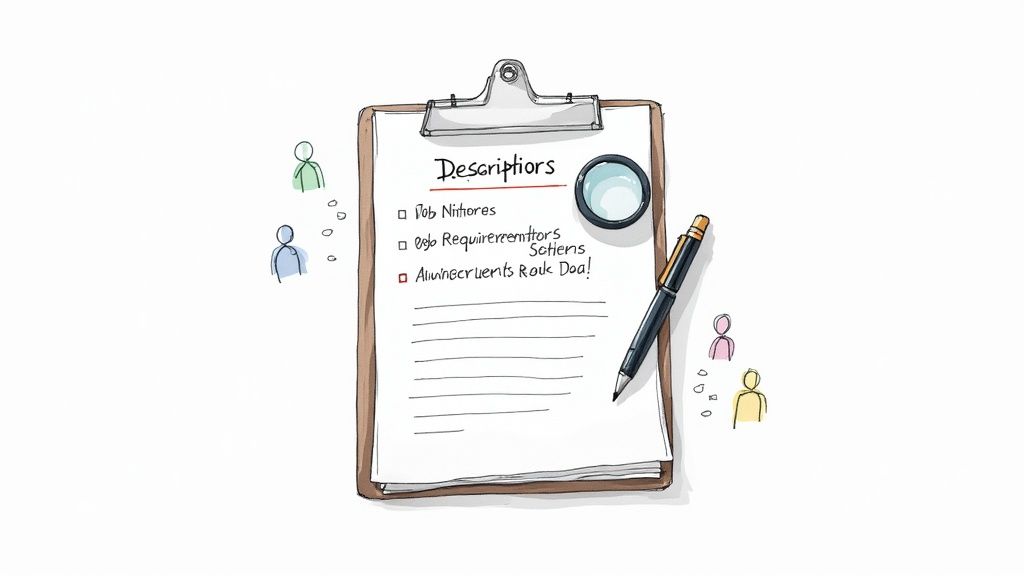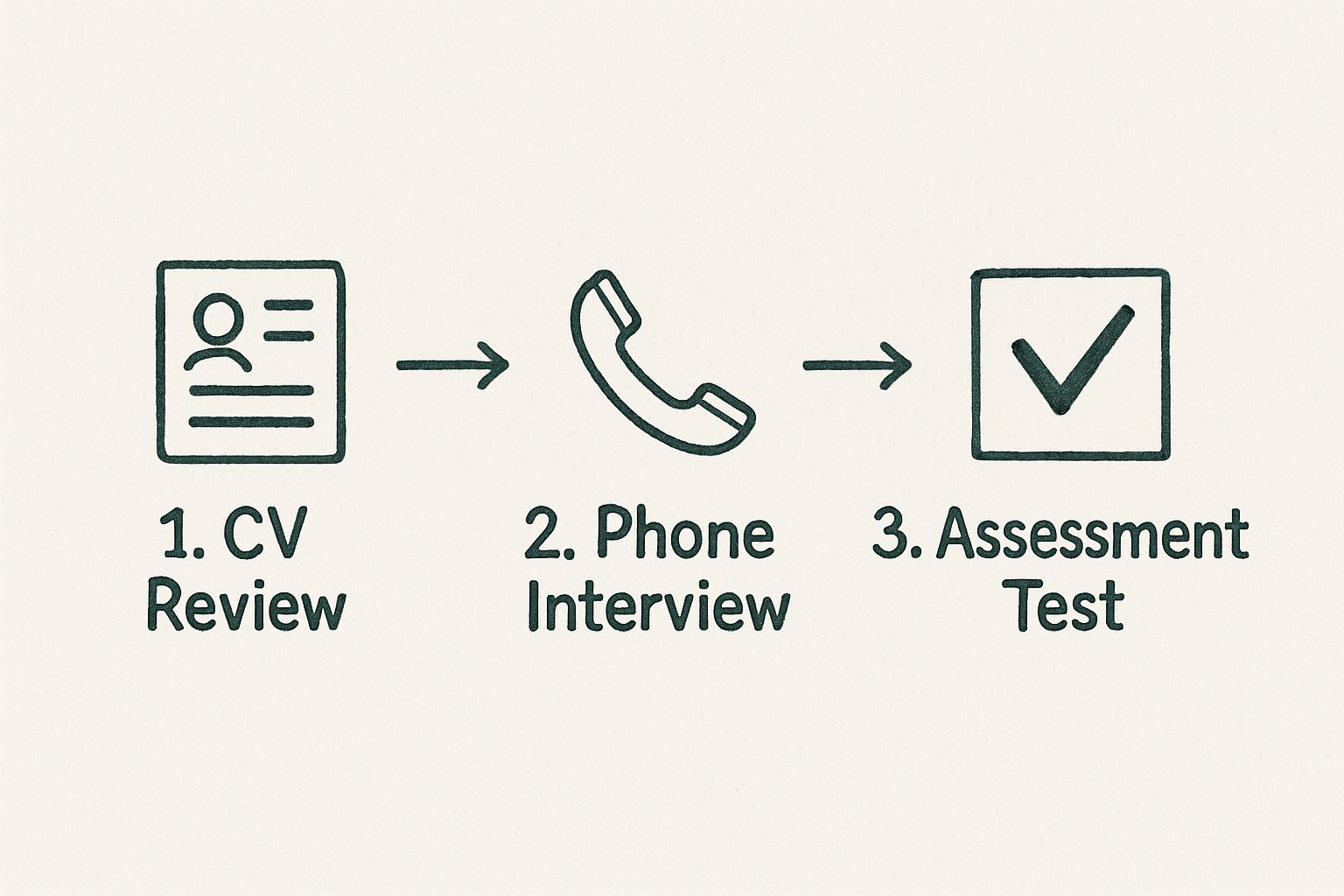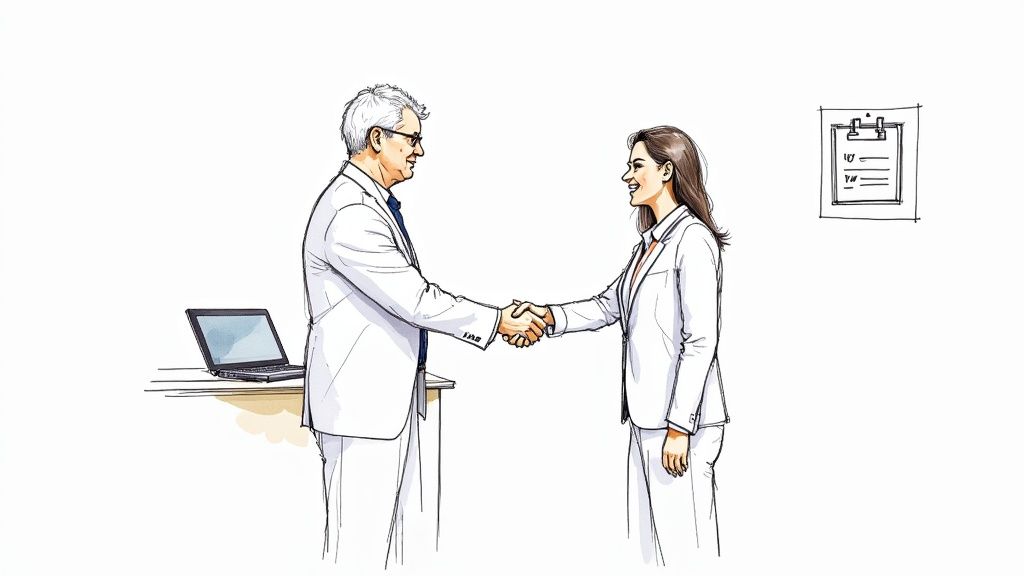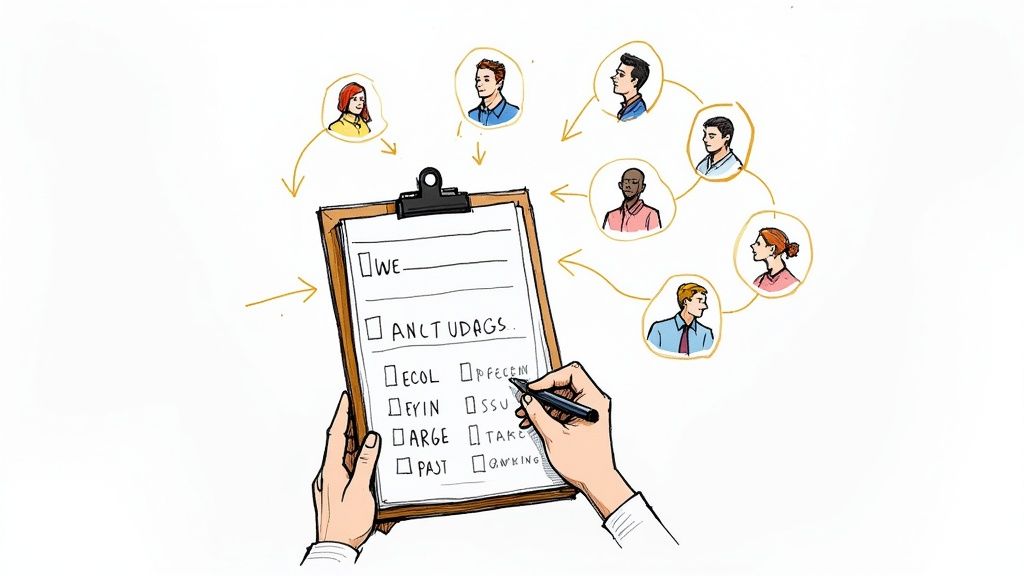A recruitment process template is your standardized, repeatable framework that maps out every single step of the hiring journey, all the way from the initial job requisition to a new hire's first day. Think of it as a playbook. It ensures every candidate gets a consistent, fair shot and, just as importantly, keeps recruiters and hiring managers perfectly aligned.
This kind of structured approach is what separates a chaotic, reactive hiring function from a predictable, strategic one.
Why a Standardized Template Is Your Secret Weapon
Let's be honest—a messy, disorganized hiring process costs you top candidates. A recruitment process template isn't just another HR document to file away. It's a powerful strategic asset that builds a predictable, scalable engine for attracting the best people in a fiercely competitive market.

This isn't about creating more red tape; it's about bringing clarity and consistency to the forefront. When everyone involved in hiring understands the game plan, decisions get made faster and communication flows smoothly. Candidates feel respected and in the loop, which does wonders for your employer brand from the very first interaction.
Before we dive deeper, it's helpful to see just how different these two approaches are. Here’s a quick look at how an unstructured hiring process stacks up against one guided by a clear, repeatable template.
The Difference Between Ad-Hoc and Template-Driven Hiring
| Hiring Aspect | Ad-Hoc (No Template) | Template-Driven |
|---|---|---|
| Consistency | Inconsistent candidate experience; varies by recruiter/manager. | Uniform process for all candidates, ensuring fairness. |
| Efficiency | Wasted time reinventing the wheel for each new role. | Streamlined workflow, faster time-to-hire. |
| Alignment | Frequent miscommunication between HR and hiring managers. | Clear roles, responsibilities, and timelines for everyone. |
| Onboarding | Disjointed; new recruiters struggle to learn the "process." | New team members get up to speed quickly with a clear guide. |
| Bias | Higher risk of unconscious bias in interviews and evaluations. | Standardized questions and criteria reduce bias. |
| Scalability | Difficult to manage a high volume of open roles. | Easily scales to handle hiring surges without sacrificing quality. |
As you can see, the contrast is stark. A template moves you from a state of constant firefighting to one of strategic control.
Building a Resilient Hiring Process
In the current climate, keeping your recruitment team stable is a huge challenge. A staggering 51% of organizations say recruiter turnover is their biggest obstacle, while 42% are bracing for even more intense competition for talent. A standardized process helps new recruiters onboard faster and keeps everything consistent, even when team members change. You can dig into more of these recruiting challenges and statistics.
A template transforms institutional knowledge from something stuck in one person’s head into an accessible, practical tool. Instead of relying on memory, your entire team has a roadmap for success, making your whole hiring function much more resilient.
It’s a lot like how an effective due diligence checklist template can bring order to a complex vetting process. A recruitment template serves as your strategic framework for hiring, offering several game-changing advantages:
- Improved Team Alignment: It gets everyone on the same page about timelines, who does what, and how candidates are evaluated. This drastically cuts down on internal friction.
- Enhanced Candidate Experience: A predictable process means candidates are kept informed and engaged, leaving them with a positive impression of your company, offer or not.
- Greater Efficiency and Scalability: You eliminate the guesswork and stop reinventing the wheel for every role. This frees you up to handle more openings without quality taking a nosedive.
- Fair and Unbiased Evaluation: By standardizing interview questions and assessment methods, you’re not just being efficient—you're creating a more equitable and fair playing field for every single applicant.
Ultimately, a well-crafted recruitment template gives you a serious competitive edge by making your hiring faster, fairer, and far more effective.
Laying a Strong Foundation for Your Template
A recruitment process template is only as good as the people who use it. You can build the most elegant, detailed process in the world, but if your hiring managers and leadership team don’t buy into it, it’s just another document collecting digital dust.
Before you even think about mapping out stages, your first move is to get everyone in the same room—recruiters, department heads, and key leaders. This isn't just about getting a rubber stamp of approval. It's about building a shared understanding and a commitment to the process. This initial kickoff meeting is where you prevent the most common point of failure: a beautifully designed template that nobody ever adopts.
The goal is to collaboratively hash out the details. Who really has the final say on a candidate shortlist? Who is on the hook for providing detailed interview feedback within 24 hours? Nailing down these roles and responsibilities from the get-go is what separates a smooth hiring process from one riddled with friction and delays.
Define Your Communication Rules
With roles clearly defined, the next step is to establish your communication ground rules. This is where so many hiring processes fall apart, leaving candidates in the dark and damaging your reputation. A staggering 83% of candidates say a bad hiring experience—often stemming from poor communication—changed their mind about a role or company they once liked.
Here's a powerful rule to build into your template's foundation: no candidate waits more than three business days for an update, at any stage. It’s a simple commitment, but one that can instantly elevate your candidate experience and employer brand.
Create a Universal Job Description Guide
Finally, let's talk about your first impression: the job description. Inconsistent, vague, or jargon-filled job posts are a huge turn-off for top talent. They won't just skip your opening; they might write off your company entirely.
Your foundational work should result in a simple guide that makes every job post clear, compelling, and consistent. Make sure every single one includes:
- A Standardized Role Summary: A consistent format that gets right to the point of the role's purpose.
- Key Responsibilities: Focus on outcomes, not just a laundry list of tasks. What will this person achieve?
- Essential Qualifications: Be crystal clear about what is a "must-have" versus a "nice-to-have." This saves everyone time.
- Company Values Statement: A short, authentic pitch on why your company is a great place to work. No corporate fluff.
Once you have this blueprint locked in, your recruitment template transforms from a mandate into a genuinely useful tool that people actually want to use.
Mapping the Key Stages of Your Recruitment Cycle
This is where you start building the engine of your hiring machine. A truly effective recruitment process template isn't just a list of tasks; it breaks the entire journey down into distinct, manageable stages. This structure is what lets you move candidates from one phase to the next with purpose, instead of just reacting to a flooded inbox.
Think of each stage as a critical checkpoint. You’re not just shuffling people along the line. You're actively qualifying them and making sure there’s a strong mutual fit. It’s the only way to sanely handle the sheer volume of applications most roles attract these days.
Just consider the numbers: globally, a single open role brings in about 73 to 74 applicants. Out of that massive pool, only about 4.3% ever land an interview, and a tiny 1.5% end up with a job offer. A well-defined recruitment cycle is what helps you sift through this volume efficiently to find those diamonds. If you want to dive deeper into these stats, StaffingHub.com has some great insights on the talent race.
Core Phases of the Recruitment Journey
Your template needs to get specific, detailing the actions, owners, and communication plan for each core phase. While you’ll want to customize these, almost every successful hiring funnel includes some version of sourcing, screening, interviewing, assessment, and offering.
For example, your Sourcing & Attraction stage is much more than just throwing a post up on a job board. It should define which channels actually deliver the best return for different roles. A software engineering role might get the best traction from targeted LinkedIn outreach, while you might find your next great customer support rep through employee referrals.
This infographic really nails the initial filtering stages that every recruitment template has to manage.

As you can see, it shows a clear progression from the initial resume review to a phone screen and then a skills assessment. It’s all about methodically winnowing down the candidate pool to the most promising few.
From Interview to Offer
The interviewing stage is often where things get messy. Your template should standardize this part of the process to slash bias and make decisions stronger. Instead of letting every interviewer ask whatever pops into their head, provide a bank of competency-based questions tied directly to the job description.
Here’s a powerful tip from my own experience: include a "knockout question" for the initial phone screen in your template. This is a single, non-negotiable question that quickly tells you if a candidate has a critical skill or meets a core requirement. It saves everyone a ton of time.
Finally, your template must map out the last crucial steps with absolute precision:
- Assessment: What kind of test is needed here? Will it be a technical take-home project, a live coding challenge, or a case study presentation? Get specific on the evaluation criteria.
- Offer & Negotiation: Document the approval workflow for the compensation package. Who needs to sign off? What's the standard process for extending the verbal offer, followed by the written one?
- Pre-boarding: That time between offer acceptance and day one is critical. Outline a clear communication plan to keep your new hire engaged and excited to join the team.
By detailing each of these phases, your recruitment process template stops being a high-level flowchart and becomes an actionable guide your team can actually use.
Integrating Modern Tools and Hiring Practices
A recruitment process template provides the essential framework, but let's be honest, modern tools are what give it real power. By plugging in the right technology, you can elevate your process from a manual checklist to an efficient, automated system that actively works for you. This isn't about replacing human judgment; it’s about amplifying it and freeing up your team to do what they do best.

Think about your Applicant Tracking System (ATS). It should be doing much more than just storing resumes. A well-configured ATS can automate communication at key stages, move candidates between stages based on feedback, and even schedule interviews automatically. A great starting point is to explore some business process automation examples to see just how many repetitive tasks you can eliminate.
Harnessing Automation and AI
Artificial intelligence is a complete game-changer, especially at the top of the funnel. It's no surprise that the adoption of AI-powered candidate assessment tools is accelerating hiring cycles by a whopping 46%. On top of that, 85% of HR professionals agree that using data analytics is essential for refining recruitment strategies.
AI can screen thousands of resumes in minutes to surface the most qualified candidates based on your specific criteria. This frees up your team from tedious manual reviews, allowing them to focus their energy on engaging with top-tier talent.
Another powerful technology to consider is asynchronous video interviewing. It allows candidates to record answers on their own time, giving your team a much richer first impression than a resume alone ever could. We dive deeper into this in our guide on how to modernize your recruitment process with on-demand asynchronous interviews.
Weaving in Best Practices
Modernizing your recruitment process template isn't just about tech; it also means embedding current best practices directly into its DNA. This ensures every action you take reinforces your company values and creates a better experience for everyone.
Here are a few practical ways to do this:
- Promote Diversity and Inclusion: Add a concrete step for a "blind review" of resumes. This means hiding identifying information to reduce unconscious bias at the earliest stage.
- Strengthen Employer Branding: Create standardized email templates in your ATS that reflect your company's unique voice and, most importantly, keep candidates informed and engaged.
- Ensure Fairness: Mandate structured interviews. This means creating a core set of questions for every role to ensure all candidates are evaluated on the exact same criteria. It's a simple change that makes a huge difference.
Measuring What Matters and Improving Your Process
Let's be clear: a great recruitment process template isn't something you create, file away, and forget. It's a living tool, one that should breathe and evolve with your hiring efforts. If you want to turn your hiring from a series of one-off tasks into a system of continuous improvement, you have to track the metrics that actually signal success, not just activity.
This means looking beyond vanity metrics like the raw number of applicants and digging into the KPIs that truly reveal the health of your process. You need a simple but powerful feedback loop.
A core principle of a data-driven recruitment process template is making adjustments based on evidence, not assumptions. If your time-to-fill is climbing, it's a clear signal that a bottleneck exists somewhere in your documented stages.
Key Metrics To Track
You don't need a massive, complicated dashboard to get started. Honestly, focusing on a few high-impact metrics is often more effective. These will tell a clear story about your hiring effectiveness.
- Time to Fill: How many days pass between posting a job and getting an offer accepted? A long timeline is a classic sign of inefficiency, often pointing to sluggish screening or interview scheduling.
- Quality of Hire: This is the ultimate test of your entire process. It’s usually measured by a new hire's performance review scores after six or twelve months on the job.
- Offer Acceptance Rate: Are your top candidates consistently turning you down? That’s a major red flag. This could signal issues with everything from your compensation and benefits to your company culture or the candidate experience itself.
Gathering this data, especially from the people who just went through the process, is where the magic happens. To keep refining your approach, understanding the right onboarding survey questions can give you invaluable insights straight from the source. This direct feedback helps you pinpoint friction points and make data-backed adjustments that keep your hiring sharp and competitive. You can also explore how automated candidate screening can directly impact and improve key metrics like your time-to-fill.
Right, so we've talked a lot about the theory behind building a killer recruitment process. But theory only gets you so far. What you really need is something you can grab and start using today.
That’s why we’ve gone ahead and built a complete, hands-on recruitment process template for you. It’s a Google Sheet, so it’s super easy to access, copy, and start molding to fit your own unique hiring needs. No need to build anything from scratch every time a new role opens up.
Think of this as your new foundation. It’s not just a blank spreadsheet; it's a fully-fleshed-out framework that already incorporates the strategies we’ve been discussing.
Take a Look Inside
Curious what you're getting? Here’s a quick peek at the template's layout to give you an idea of how it all works.

As you can see, everything is laid out to clearly map the candidate's journey from their initial application right through to the final offer. This gives your entire team instant visibility into your pipeline, with each stage acting as a clear checkpoint to keep everyone aligned and consistent.
Get Your Free Template Here [Link to Download]
To really get the most out of this, remember to standardize how you're assessing candidates at each stage. This template works perfectly alongside a structured interview evaluation form, which is a fantastic way to reduce bias and ground your hiring decisions in solid data. Just download the template, tweak it to match your workflow, and start making better hires.
Got Questions About Your Recruitment Template?
Even with the best-laid plans, a few questions always pop up when you start rolling out a new hiring framework. Let's tackle some of the most common ones we hear from HR pros. Getting these sorted out early on will make sure your new process is adopted smoothly and actually makes a difference.
How Often Should We Update Our Recruitment Process Template?
Think of your recruitment template as a living document, not something you set in stone and forget. A good rule of thumb is to give it a thorough review at least once a year. But honestly, the best trigger for an update is always real-world feedback.
If your hiring managers keep grumbling about the same bottleneck, or new hires mention a confusing step during their onboarding, that's your cue. It’s a clear sign that a part of your process needs a tune-up. Big company shifts, like a round of hyper-growth or a new strategic direction, also mean it's time for a refresh.
Can One Template Really Work for All Roles?
Yes and no. The smartest way to handle this is to have a core master template that covers the big-picture stages, but then create variations for different types of roles—think technical, sales, or executive positions. This gives you that crucial consistency while still allowing for the flexibility you absolutely need.
The main stages—like sourcing, screening, and interviewing—should stay the same for every role to ensure fairness and a consistent experience. But the nitty-gritty details within those stages, like the specific interview questions, the type of skills assessment you use, or which department heads need to be involved? That’s what needs to be tailored.
The goal isn't rigid conformity. It’s about creating a consistent, positive journey for every candidate, no matter the role they're applying for.
What Is the Most Important Metric for Recruitment Success?
While Quality of Hire is the holy grail, it’s a lagging indicator—you won't have solid data on it for months. If you want more immediate feedback on how well your template is working, keep a close eye on two metrics: Time to Fill and Candidate Experience Score.
A long Time to Fill is often a flashing red light for bottlenecks in your process. At the same time, a poor Candidate Experience Score can be a silent killer for your employer brand. In fact, a staggering 83% of candidates say a negative interview experience was enough to make them change their mind about a company they were once excited about.
At Async Interview, we help you tackle these challenges head-on. Our platform streamlines the early stages of your recruitment process, reducing Time to Fill and ensuring every candidate has a professional, engaging experience. See how you can hire up to 10x faster.




